《DSP using MATLAB》Problem 8.32

代码:
%% ------------------------------------------------------------------------
%% Output Info about this m-file
fprintf('\n***********************************************************\n');
fprintf(' <DSP using MATLAB> Problem 8.32 \n\n');
banner();
%% ------------------------------------------------------------------------
% -------------------------------------
% Ω=(2/T)tan(ω/2)
% ω=2*[atan(ΩT/2)]
% Digital Filter Specifications:
% -------------------------------------
wp = 0.3*pi; % digital passband freq in rad
ws = 0.4*pi; % digital stopband freq in rad
Rp = 0.25; % passband ripple in dB
As = 50; % stopband attenuation in dB
Ripple = 10 ^ (-Rp/20) % passband ripple in absolute
Attn = 10 ^ (-As/20) % stopband attenuation in absolute
% Analog prototype specifications: Inverse Mapping for frequencies
T = 1; % set T = 1
Fs = 1/T;
OmegaP = (2/T)*tan(wp/2) % prototype passband freq
OmegaS = (2/T)*tan(ws/2) % prototype stopband freq
% Analog Elliptic Prototype Filter Calculation:
[cs, ds] = afd_elip(OmegaP, OmegaS, Rp, As);
% Calculation of second-order sections:
fprintf('\n***** Cascade-form in s-plane: START *****\n');
[CS, BS, AS] = sdir2cas(cs, ds)
fprintf('\n***** Cascade-form in s-plane: END *****\n');
% Calculation of Frequency Response:
[db_s, mag_s, pha_s, ww_s] = freqs_m(cs, ds, 0.5*pi/T);
% Calculation of Impulse Response:
[ha, x, t] = impulse(cs, ds);
% Impulse Invariance Transformation:
%[b, a] = imp_invr(cs, ds, T);
% Bilinear Transformation
[b, a] = bilinear(cs, ds, Fs)
[C, B, A] = dir2cas(b, a)
% Calculation of Frequency Response:
[db, mag, pha, grd, ww] = freqz_m(b, a);
%% -----------------------------------------------------------------
%% Plot
%% -----------------------------------------------------------------
figure('NumberTitle', 'off', 'Name', 'Problem 8.32 Analog Elliptic lowpass')
set(gcf,'Color','white');
M = 1.0; % Omega max
subplot(2,2,1); plot(ww_s/pi, mag_s); grid on; %axis([-10, 10, 0, 1.2]);
xlabel(' Analog frequency in \pi units'); ylabel('|H|'); title('Magnitude in Absolute');
set(gca, 'XTickMode', 'manual', 'XTick', [-0.4625, -0.3244, 0, 0.3244, 0.4625]);
set(gca, 'YTickMode', 'manual', 'YTick', [0, 0.0032, 0.9716, 1.0, 1.5]);
subplot(2,2,2); plot(ww_s/pi, db_s); grid on; %axis([0, M, -50, 10]);
xlabel('Analog frequency in \pi units'); ylabel('Decibels'); title('Magnitude in dB ');
set(gca, 'XTickMode', 'manual', 'XTick', [-0.4625, -0.3244, 0, 0.3244, 0.417, 0.458, 0.4625]);
set(gca, 'YTickMode', 'manual', 'YTick', [-50, -1, 0]);
set(gca,'YTickLabelMode','manual','YTickLabel',['50';' 1';' 0']);
subplot(2,2,3); plot(ww_s/pi, pha_s/pi); grid on; %axis([-10, 10, -1.2, 1.2]);
xlabel('Analog frequency in \pi nuits'); ylabel('radians'); title('Phase Response');
set(gca, 'XTickMode', 'manual', 'XTick', [-0.4625, -0.3244, 0, 0.3244, 0.4625]);
set(gca, 'YTickMode', 'manual', 'YTick', [-1:0.5:1]);
subplot(2,2,4); plot(t, ha); grid on; %axis([0, 30, -0.05, 0.25]);
xlabel('time in seconds'); ylabel('ha(t)'); title('Impulse Response');
figure('NumberTitle', 'off', 'Name', 'Problem 8.32 Digital Elliptic lowpass by bilinear')
set(gcf,'Color','white');
M = 2; % Omega max
subplot(2,2,1); plot(ww/pi, mag); axis([0, M, 0, 1.2]); grid on;
xlabel(' Digital frequency in \pi units'); ylabel('|H|'); title('Magnitude Response');
set(gca, 'XTickMode', 'manual', 'XTick', [0, 0.3, 0.4, 1.6, 1.7, M]);
set(gca, 'YTickMode', 'manual', 'YTick', [0, 0.0032, 0.9716, 1]);
subplot(2,2,2); plot(ww/pi, pha/pi); axis([0, M, -1.1, 1.1]); grid on;
xlabel('Digital frequency in \pi nuits'); ylabel('radians in \pi units'); title('Phase Response');
set(gca, 'XTickMode', 'manual', 'XTick', [0, 0.3, 0.4, 1.6, 1.7, M]);
set(gca, 'YTickMode', 'manual', 'YTick', [-1:1:1]);
subplot(2,2,3); plot(ww/pi, db); axis([0, M, -80, 10]); grid on;
xlabel('Digital frequency in \pi units'); ylabel('Decibels'); title('Magnitude in dB ');
set(gca, 'XTickMode', 'manual', 'XTick', [0, 0.3, 0.37, 0.4, 1.6, 1.7, M]);
set(gca, 'YTickMode', 'manual', 'YTick', [-60, -50, -1, 0]);
set(gca,'YTickLabelMode','manual','YTickLabel',['60';'50';' 1';' 0']);
subplot(2,2,4); plot(ww/pi, grd); grid on; %axis([0, M, 0, 35]);
xlabel('Digital frequency in \pi units'); ylabel('Samples'); title('Group Delay');
set(gca, 'XTickMode', 'manual', 'XTick', [0, 0.3, 0.4, 1.6, 1.7, M]);
%set(gca, 'YTickMode', 'manual', 'YTick', [0:5:35]);
figure('NumberTitle', 'off', 'Name', 'Problem 8.32 Pole-Zero Plot')
set(gcf,'Color','white');
zplane(b,a);
title(sprintf('Pole-Zero Plot'));
%pzplotz(b,a);
% ----------------------------------------------
% Calculation of Impulse Response
% ----------------------------------------------
figure('NumberTitle', 'off', 'Name', 'Problem 8.32 Imp & Freq Response')
set(gcf,'Color','white');
t = [0:0.01:90]; subplot(2,1,1); impulse(cs,ds,t); grid on; % Impulse response of the analog filter
axis([0,90,-0.2,0.3]);hold on
n = [0:1:90/T]; hn = filter(b,a,impseq(0,0,90/T)); % Impulse response of the digital filter
stem(n*T,hn); xlabel('time in sec'); title (sprintf('Impulse Responses T=%2d',T));
hold off
% Calculation of Frequency Response:
[dbs, mags, phas, wws] = freqs_m(cs, ds, 2*pi/T); % Analog frequency s-domain
[dbz, magz, phaz, grdz, wwz] = freqz_m(b, a); % Digital z-domain
%% -----------------------------------------------------------------
%% Plot
%% -----------------------------------------------------------------
subplot(2,1,2); plot(wws/(2*pi), mags/T,'b', wwz/(2*pi*T), magz, 'r'); grid on;
xlabel('frequency in Hz'); title('Magnitude Responses'); ylabel('Magnitude');
text(-0.8,0.15,'Analog filter', 'Color', 'b'); text(0.8,0.4,'Digital filter', 'Color', 'r');
运行结果:
这里主要放双线性变化法的代码。
通带、阻带绝对指标,模拟滤波器截止频率指标,
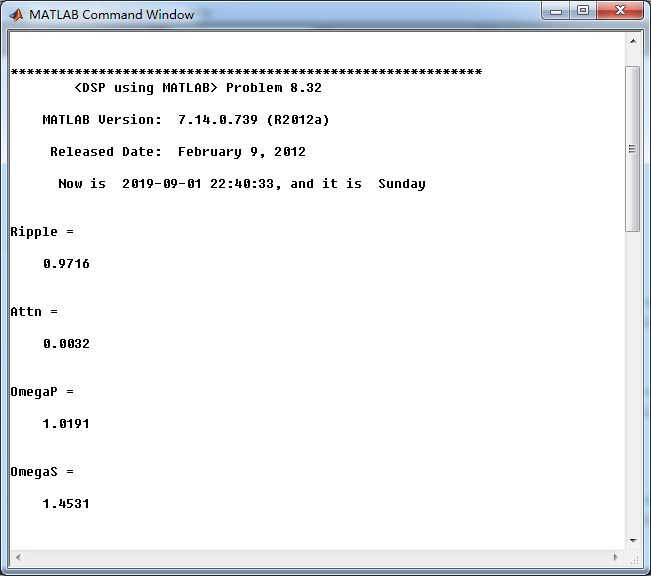
模拟Elliptic原型低通滤波器,系统函数串联形式的系数
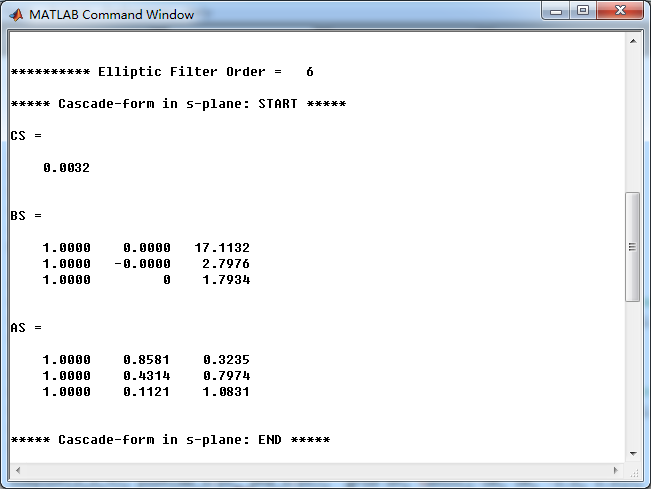
采用双线性变换法,得到数字Elliptic低通滤波器,系统函数直接形式的系数,转换成串联形式的系数
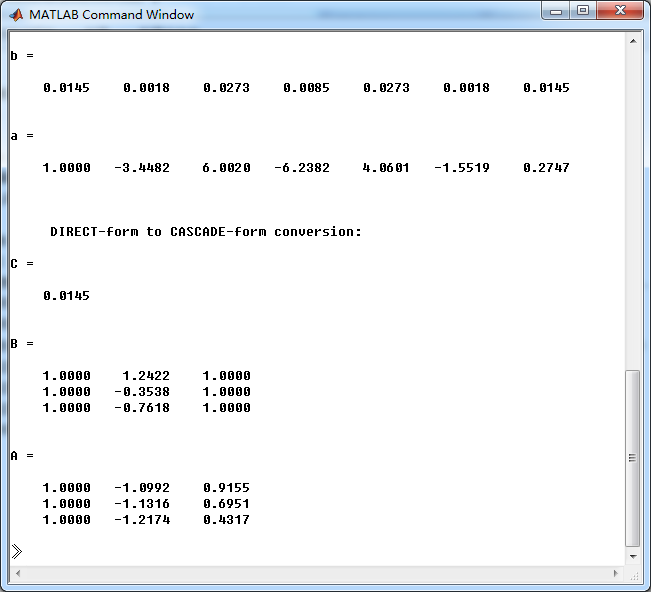
模拟Elliptic原型低通滤波器,其幅度谱、相位谱和脉冲响应
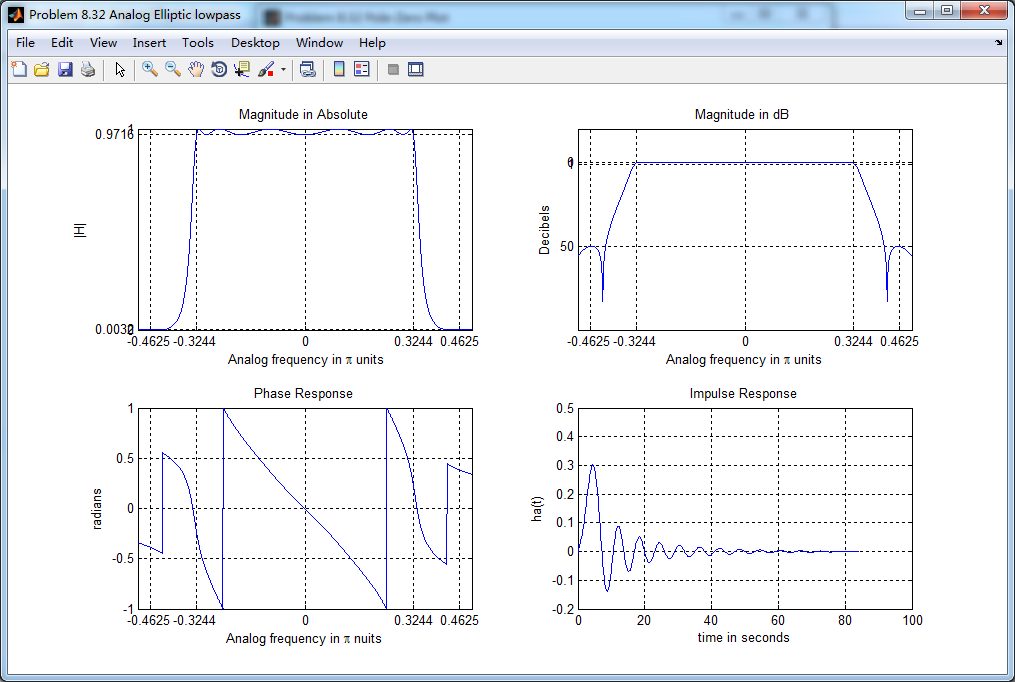
采用双线性变换法(bilinear)得到数字Elliptic低通滤波器,其幅度谱、相位谱和群延迟响应

数字Elliptic低通系统函数零极点图

模拟原型和数字低通的脉冲响应对比,可见双线性变换法不保留脉冲响应的形态。
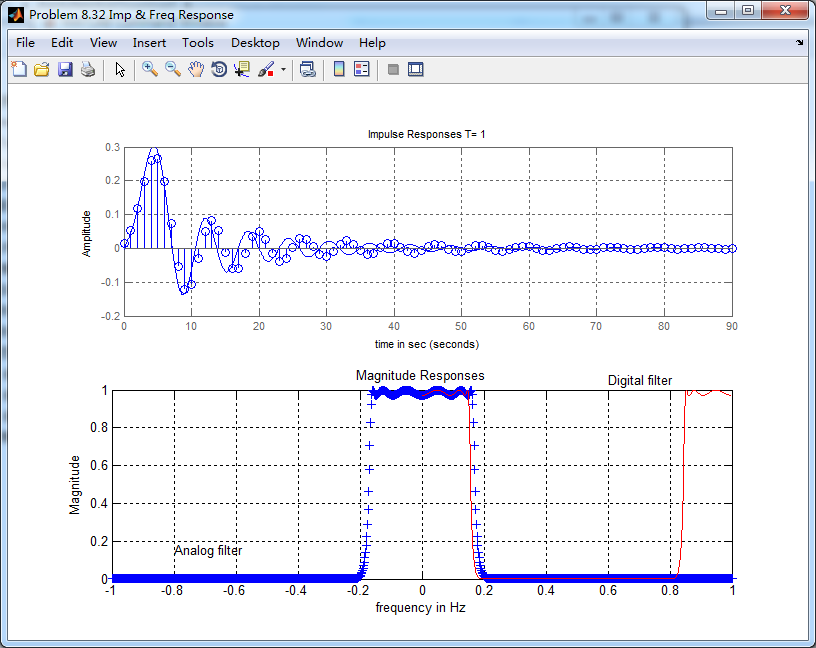
使用MATLAB自带ellip函数的运算结果这里就不写了,只放张幅度谱、相位谱和群延迟响应的图,可见和双线性变换法得到的结果相比,区别不大。
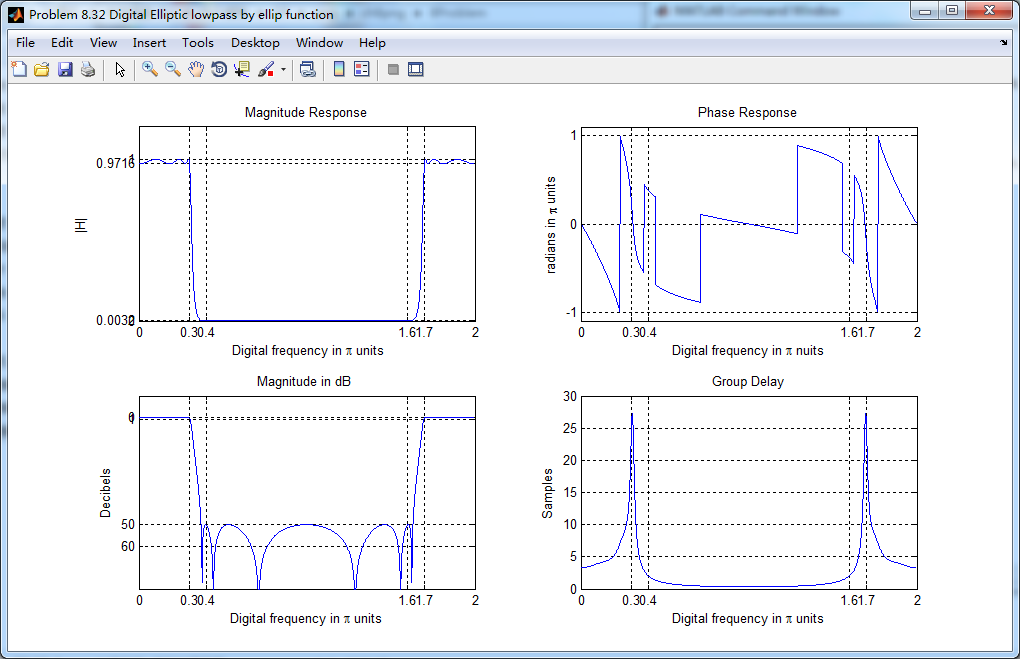
牢记:
1、如果你决定做某事,那就动手去做;不要受任何人、任何事的干扰。2、这个世界并不完美,但依然值得我们去为之奋斗。




 浙公网安备 33010602011771号
浙公网安备 33010602011771号